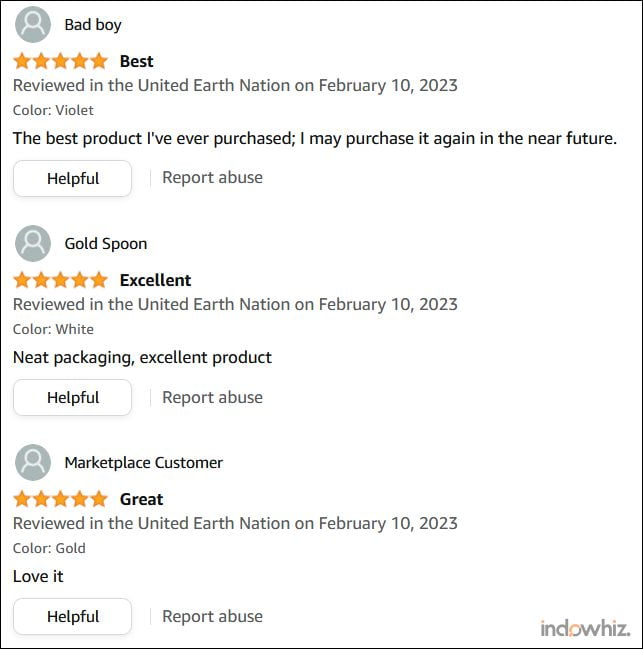In this digital age, there are many conveniences that we get from online transactions for buying and selling products, services, and applications. However, we must be vigilant against acts of fraud in online transactions. One of them is by paying attention to the ratings and reviews of a product or service we intend to purchase.
1. Online vs offline shopping
Offline shopping means that buyers go directly to the store’s physical location and make transactions there. Then, the physical form, color, and detailed characteristics of a product are all things we can feel directly. For example, if we go straight to a clothing store, we can usually try it on before purchasing.
When we want to buy a product through an online store or marketplace, on the other hand, we can only view photos or videos of the product. Most of the time, the only way to determine a product’s quality is to look at its ratings and reviews. Even the most detailed product description cannot directly depict the actual physical product. For example, we cannot feel the material, size, or comfort of clothing while wearing it. Furthermore, the color of the product displayed on your cellphone or computer may differ slightly from the original color. We won’t know all of those details until we buy it from an online store or marketplace and receive the product.
In some cases, even if a product in an online store or marketplace has a high rating, some people regret purchasing it. It’s because they are not careful enough to pay attention to product descriptions, ratings, and reviews. Generally, most people only look at the average rating of an online product and disregard previous reviews.
2. Ratings and reviews of online product
Ratings are satisfaction evaluations of a product by its users, or consumers. This is a general indicator of how good or popular a product is. Ratings are typically given on a scale of 1–5 or 1–10, as illustrated in Figure 1.

In contrast, reviews are typically more detailed. It contains user or consumer opinions based on their experience and level of satisfaction with the product. An objective review (as shown in Figure 2), along with the product’s pros and cons, greatly assists other users in deciding whether or not to purchase the product. However, to obtain more information, we must also consider other reviews of the same products.

3. Fake ratings and reviews
In general, the higher the rating, the more users or consumers are interested in using the product. This may have a positive impact on the store’s profit value. For that reason, sometimes dishonest sellers justify any means to increase the rating on their product. One method is to provide hundreds or thousands of fake reviews to boost their product ratings. In addition, dishonest sellers can also do this to lower the rating of their competitor’s product.
Adding fake reviews appears to be the simplest way for dishonest sellers to get away with it. There could be tens, hundreds, or even thousands of fake reviews that are not from verified customers. The goal is to raise the average rating to more than 4.0 on a 5-point scale. In general, they do this by either paying specific parties or using specific software.

Look at Figure 3, where all three reviews are most likely fake. The majority of the writing is superficial, not detailed, uses general sentences, and is completed in a short period of time.
This “fake reviews” are also common on many social media platforms. It is possible to accomplish this by purchasing Instagram or Twitter followers or YouTube video viewers.
Review hijacking
Jake Swearingen discovers an Amazon fraud case that appears on Consumer Reports. This case involves some dishonest shop owners who take advantage of a security flaw. They present their product as having a high rating and having been reviewed by thousands of customers.
There is a product called “Headphone Jack Adapter,” as shown in Figure 4. It is an “Amazon’s Choice” item with over 4,400 reviews and a rating of 4.3 out of 5. As a result, the product looks decent enough for other users to buy it. They anticipate that the majority of buyers will have tried it and expressed satisfaction with the product.

However, after reading some of the reviews, it appears that something is off. How come the product is titled “Headphone Jack Adapter,” but the reviews are for a motherboard extension, a thermos, or even a computer duster?

After investigating, it turned out that dishonest store owners replaced high-rated products with other new products. They may initially sell motherboard extensions and receive positive feedback within a month. Then, in the following period, they changed the page to sell other products (such as a thermos). Later, they changed the page again to sell adapter headphones.
As a result, positive reviews will continue to grow, which is why the average rating is always high. Even if the second or future products get negative reviews and low ratings, it won’t affect the average rating. Essentially, they hijack positive reviews from previous product sales to promote their own products.
Bad competitors
Many online store owners are truthful and fair when it comes to increasing the ratings on their products. When it comes to seller competition, however, some sellers may act dishonestly or maliciously in order to put other sellers in trouble, such as:
- They leave numerous negative and false reviews on competing products. This can result in decreased sales of competitors’ products or even their suspension from the market.
- They leave a large number of positive fake reviews (5 stars) on competitor products, leading the marketplace administrator to believe the product is a scam.
- They file an intellectual property (IP) infringement complaint against a competitor’s product.
- Bribing marketplace employees to gain access to internal system data. This can be used to view internal competition, suspended accounts, and other information.
Illegal Paid Review
Sellers prefer high ratings, whereas buyers prefer incentives such as discounts, cashback, and gifts. As a result, demand and supply may exist in addition to the product itself.
Sellers may also make unique paid review offers on social media. As shown in Figure 6, they may offer their product for free with an additional commission to anyone who gives it a good rating and review. Unfortunately, many people are interested and agree to the offer.

The procedure is simple and beneficial to both parties. Initially, the seller advertised his offer on social media. It is usually followed by “money back, +commission for 5 stars, PM for more details.” The interested party will then send a private message to the seller. Transactions are completed, ranging from purchasing products and shipping to providing product reviews in online stores or marketplaces. After checking, the seller returns the money plus the commission.
The sellers are well aware that what they are doing is illegal. They reasoned, however, that they have many competitors who sell the same product. Despite the fact that they make genuine offers, it is illegal under online marketplace regulations.
Characteristics of fake reviews
The following are the most common characteristics used to determine whether a review is fake:
- Lack of detail.
In general, explaining something we have never experienced will be difficult. For example, most people will provide feedback on their hotel experience in terms of room size, bathroom condition, communication, and price. Meanwhile, fake reviews are typically more general, such as “scenery” and “holidays,” and contain general sentences with little detail. - Commercial phrase.
Even if the majority of people like the product, there is always a “but” in this imperfect world. They write extensively about their personal experiences, but not so much about product names. In contrast, fake reviews typically include a detailed product name, such as “I like VWXYZ brand USB cables.” Then, it followed by boasting about features and specifications that may or may not be true. - A large number of reviews in a short period of time.
We must exercise caution if we see a large number of reviews in a short period of time or at the same time. Furthermore, everyday items like cables, pencils, tissues, HVS paper, and so on are rarely reviewed.
4. Do some research before checking out.
There are numerous factors to consider before making a purchase from an online store or marketplace. In reality, we must conduct studies on these products as well. Here are some pointers to help you avoid buying goods with fake reviews.
Pay attention to the rating distribution
The first thing we need to pay attention to when choosing online products is the rating distribution. In general, we need to comprehend several variants, as illustrated in Figure 7.

Here’s the explanation:
- Figure 7 (a): a standard or good product.
A good or standard-quality product with honest reviews generally appears to have ratings with a normal distribution. If the product we choose has a rating like this, then we can save it. We can then compare it to other comparable products. - Figure 7 (b): an excellent product.
Sometimes a product receives a high ranking simply because it is excellent. The users or customers are extremely pleased with it. The rating distribution is usually a mirrored “7,” and desired by many sellers or vendors. However, many of them act dishonestly in order to acquire a rating distribution like this. - Figure 7 (c): a suspicious product.
We may have seen a product with rating distribution that mimics the letter “C.” Then, we describe this product as suspicious for several reasons:- Originally, a product receives a lot of positive feedback. Then, either the product’s quality or the store’s service begins to deteriorate. Eventually, it received a large number of negative reviews.
- On the contrary, a product may initially get a lot of negative feedback. The seller then tries to enhance the service’s or product’s quality in order to raise its rating. Eventually, it received a lot of positive feedback.
- Perhaps there is no difference in the quality of both the merchandise and the store’s services. However, either the seller purchases a large number of fictitious high ratings or a bad competitor purchases fictitious low ratings. Eventually, the overall ranking would alter as a result of either move.
- Figure 7 (d): a bad product.
Low-rated products typically have something that is disliked. First, it could be due to bad product quality. Second, even if the product is excellent, the store service may have terrible service. I would personally avoid a product with this rating distribution.
Consider reading some of the reviews.
Simply glancing at the overall rating of a product is insufficient. We should also take the time to read some of its reviews. Several factors to consider as you examine the reviews are:
- Are they using exaggeration?
- Is it too short or too long?
- Is the content specific enough?
- Is the content helpful in deciding whether or not to make a purchase?
- Does the author also often provide reviews elsewhere?
Gambar sampul diambil dari freepik.



